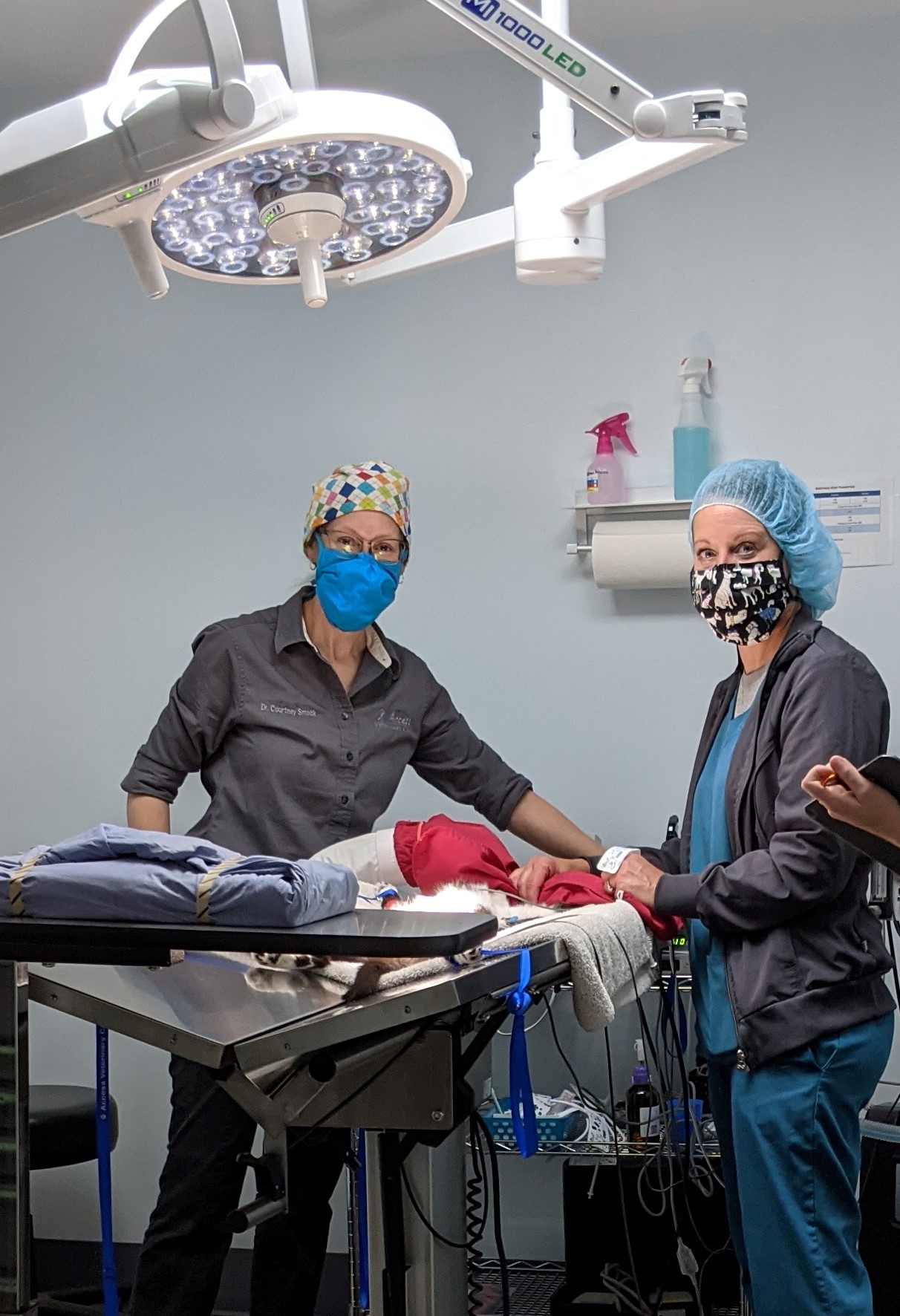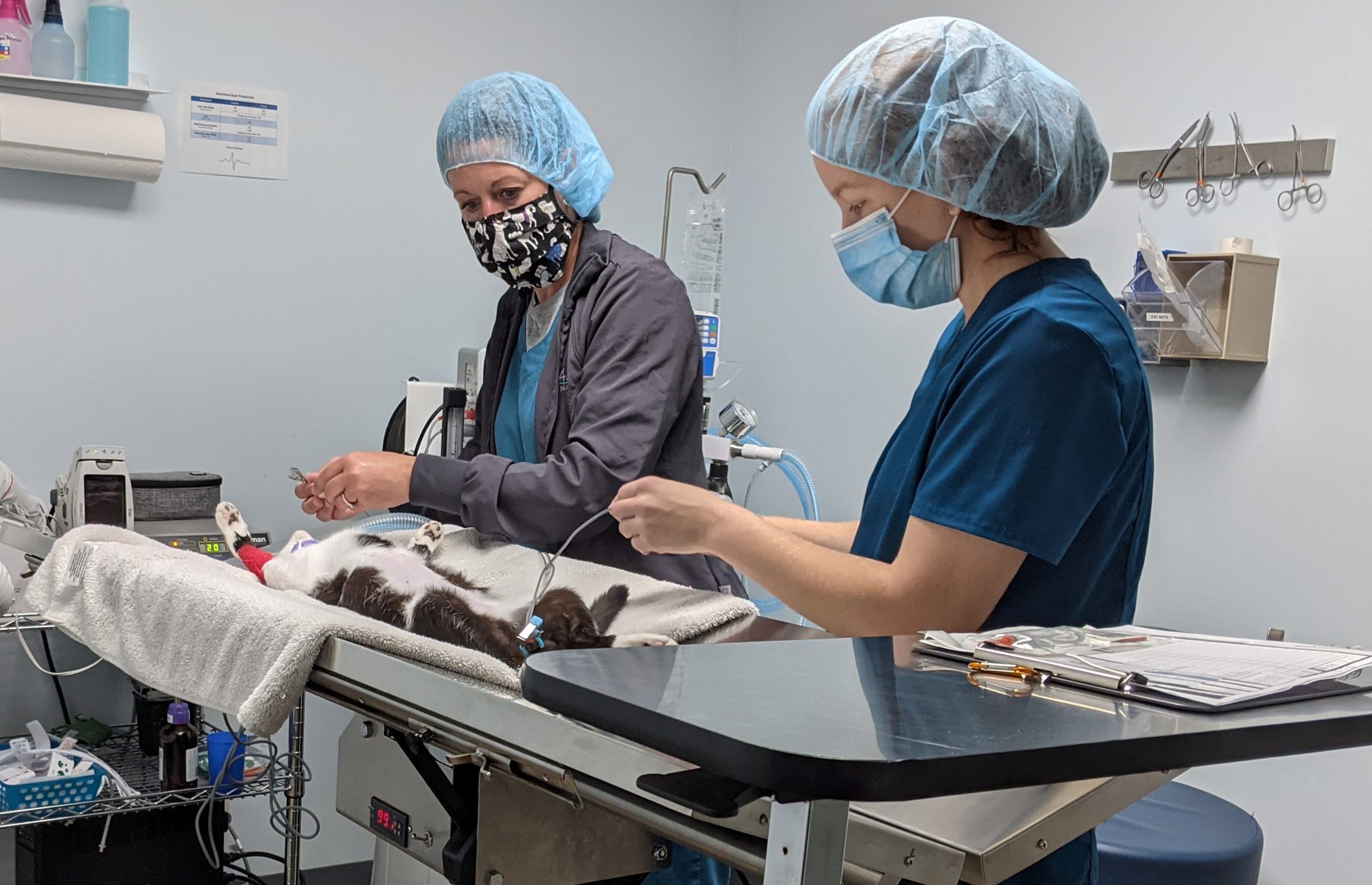Surgery
Surgical Services at AVC
AVC offers a full range of surgical services, from routine spay and neuter to complicated soft tissue surgeries.
We are adamant about investing in the best training and equipment to ensure any procedure performed on your pet is as safe and effective as possible. Find out more about our facility and some of our specialized services below.

Radiosurgery
Radiosurgery is an advanced surgical technology that uses high-frequency energy to vaporize tissue, allowing extremely precise incisions with minimal bleeding or damage to surrounding tissues.
How Does Radiosurgery Benefit My Pet?
There are many, many advantages:
- Less bleeding means faster procedures and less anesthesia.
- Precise, highly controlled incisions lead to better surgical outcomes.
- Less bleeding and tissue swelling make many specialty procedures safer and easier, such as soft palate and nasal surgery to improve breathing in certain breeds.
- Less post-operative pain and better healing when compared to similar modalities (laser and electrocautery).
How Does It Compare To Laser Surgery?
Radiosurgery offers the same benefits of laser surgery – in fact, in almost every aspect radiosurgery improves on those benefits. Studies have shown radiosurgery results in less damage to surrounding tissues, less post-operative discomfort, and better healing when compared to laser. A good review of multiple studies comparing the two can be found here. Radiosurgery is also less expensive – our unit cost about 1/4 of what an entry-level surgical laser runs.
What Procedures Does AVC Use Radiosurgery For?
Every one it’s appropriate for, and that’s almost all of them! Nearly all surgical incisions are done with radiosurgery, and there are no added fees – we always use the best tools we have to give your pet the best outcome possible. Some procedures radiosurgery is particularly valuable for include:
- Declaws
- Mass removals (small masses may even be able to be done without full anesthesia)
- Soft palate resection (often recommended in breeds like bulldogs and pugs)
- Eyelid surgery
- Gingivectomy
Spay & Neuter Services
Spay & neuter procedures are routine, but it is important to remember that they are surgical procedures performed under general anesthesia. With that in mind, we ensure your pet’s procedure is as safe and pain-free as possible. Every surgery at AVC receives:
- IV catheter placement for fluids to maintain blood pressure, and for quick access in case of emergency
- Complete monitoring of pulse, respiration, electrocardiogram, oxygenation, and blood pressure by a trained technician/assistant
- Complex, modern anesthetic protocols for improved safety
- Pre-, post-, and intra-operative pain medications to maximize comfort
At AVC, your pet’s comfort and safety is never optional. As such, our surgical prices are not the cheapest, but we promise you they are the best value you will find for the level of care provided – and we know value and safety are most important to our clients.
Pre-Surgical Consult & Estimate
Each pet is unique – some are large, some are small, others may have additional issues that need addressed while under anesthesia. That’s why we require a quick, reduced cost Pre-Surgical Consult* prior to scheduling any surgery. The consult gives the Veterinarian a chance to screen for any problems, make a plan to deal with them, and give you an accurate estimate of costs. We don’t want surprises during surgery, and you don’t want surprises at check-out.
While we cannot tell you what a surgery will cost for your pet until we see them, most dog neuters cost around $250-350 and dog spays start around $350 for small, young dogs – though a large adult female may cost substantially more. Feline spays typically start around $250.
* Pre-Surgical Consults include a brief evaluation by a DVM and assistant to screen for issues that may complicate the procedure or anesthesia. Any additional issues, or consultation outside the scope of the surgery, will require a standard exam at the usual fee.
Gastropexy
“Bloat” is a condition where a dog’s stomach becomes swollen with food or air. Since the stomach can move freely in their belly, it can also rotate on itself when this happens, cutting off its blood supply. This life-threatening emergency is particularly common in large, deep-chested breeds like Labradors, Great Danes, German Shepherd Dogs, and Boxers. In fact, this condition used to be the leading cause of death in Military Working Dogs.
Fortunately, there is a surgical procedure that can prevent this life-threatening problem. An incisional gastropexy involves making a 2-4cm incision in the outer layers of the stomach and suturing that to a similar incision in the body wall. The two incisions heal or “scar” together, fixing the stomach in the belly so it can no longer rotate – thus preventing the deadly condition described above.
Dr. Rowland learned to do this procedure during his time in the Army – which now performs it on all Military Working Dogs, turning their previous leading cause of death into a very rare issue. He has performed many gastropexys since, and strongly recommends the procedure on any high-risk breeds. It is most commonly performed at the time of spay or neuter, but can be done at any point.
Anesthesia
Few things make owners as nervous as anesthesia. Heck, when I was first unleashed upon the world as “Dr. Rowland” anesthesia wracked my nerves way more than surgery. I distinctly remember the first time I knocked a patient out – I calculated the dose, double-checked it, then looked it up and checked it again, then read the drug monogram for the Nth time and checked the dose several more times. I’ve gotten over that, of course. Wouldn’t see many patients at that rate!
Here’s the thing – with the right drugs, good monitoring, and a relatively healthy patient anesthesia is quite safe. But anesthesia is never without risk, and should never be taken lightly. Today’s article is geared toward relieving the anxiety most of us feel when our pets need to be anesthetized – by giving you knowledge about what the risks really are, and what we (vets and owners) can do to minimize them.
Read More
